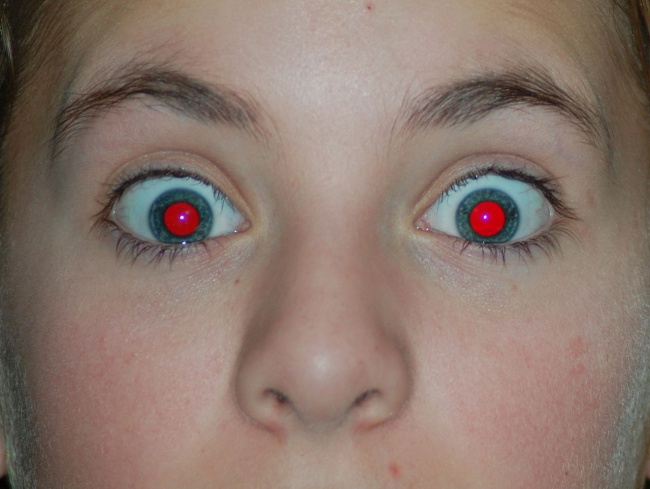Why does it take 'red' when taking photos of your eyes that look like 'vampires'?
Although the current technology simplifies capturing art shots, the "red eye" effect is still the cause of ruining many of your beautiful photos. Bright Side decided to investigate the cause of this "strange" effect.
In ambient light, you often have to open your eyes to allow light to enter. When the flash light hits your eyes, you won't have enough time to squint your eyes. Therefore, the amount of strong light from the lamp makes the scene light up and directly affects the eyeball, passing through the pupil to the rear blood vessels, reflecting red blood vessels on the veins. When the camera flash lights up reflecting this blood vessel, our eyes often have a "red" effect on the image.
 Why does it take 'red' when taking photos of your eyes that look like 'vampires'? Picture 1
Why does it take 'red' when taking photos of your eyes that look like 'vampires'? Picture 1
Light directly affects the eyeball, passing through the pupil to the rear blood vessel.
The reason why the eyes are red is probably because you stare at the camera's lens . You can eliminate the "red eye" effect in a simple way that is to avoid staring at the lens but just looking at a nearby light bulb before taking a picture.
To reduce the "red-eye" effect, most modern cameras often flash the front flash before the flash officially blinks, so you have enough time to squint your eyes and adapt to it.
 Why does it take 'red' when taking photos of your eyes that look like 'vampires'? Picture 2
Why does it take 'red' when taking photos of your eyes that look like 'vampires'? Picture 2
The intensity of light reflection of each person is different, depending on the size, age and eye color of each individual. People with bright skin and blue or green eyes are less likely to be melanin (pigment-forming epidermal cells), which can often suffer from "red-eye" effects when taking pictures.
High-quality effects often appear in the eyes of humans and animal eyes, especially in the eyes of nocturnal animals - the retina has a special reflective layer called the tapetum lucidum mirror that acts as a mirror placed behind the eyes. This tissue helps animals see things better at night with actions like reflectors (retroreflector), taking reflected light and directly reflecting it back to its original direction.
 Why does it take 'red' when taking photos of your eyes that look like 'vampires'? Picture 3
Why does it take 'red' when taking photos of your eyes that look like 'vampires'? Picture 3
You should read it
- Eliminate red-eye effect and make animated images with Photoscape
- Crystal whirlpools on the top of the Andes, an unprecedented phenomenon in history
- Instructions for troubleshooting Flash Player crash (crash) in the browser
- 5 'very toxic' tips help improve photography skills in just 1 minute
- 10 simple photography techniques for impressive photos
- Instructions for taking photos with flash
- Why go to the sun on everyone will be dizzy?
- C # program structure
- 5 types of photos ideal for those who like to travel
- What is the best URL structure for SEO?
- The harsh truths in photography
- 5 best free photography learning websites
May be interested

Simple way to measure air quality in your home

Explore the world's deepest underwater caves in the Czech Republic

11 famous inventions and inventions of Vietnamese people made the world admire

Science proves: Children inherit intelligence from their mother, not from their father

Explain the cause of an electric shock when you bend your elbow on the table

Top 10 fastest growing industries in 2016






 4 ways to take photos with rain give the picture more romantic part
4 ways to take photos with rain give the picture more romantic part Complete the Photos app on iPhone / iPad - Part 4: Edit photos
Complete the Photos app on iPhone / iPad - Part 4: Edit photos 21 'weird' photos are real that you can't believe your eyes
21 'weird' photos are real that you can't believe your eyes Dwarf mushrooms want to increase height when taking photos? Use a heightened 'cheat' way like Mark Zuckerberg
Dwarf mushrooms want to increase height when taking photos? Use a heightened 'cheat' way like Mark Zuckerberg Photograph fireworks with smartphone camera
Photograph fireworks with smartphone camera The series of real photos looks like fake to make viewers bewildered
The series of real photos looks like fake to make viewers bewildered